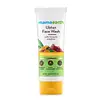What's inside
What's inside
 Key Ingredients
Key Ingredients

 Benefits
Benefits

 Concerns
Concerns

 Ingredients Side-by-side
Ingredients Side-by-side

Water
Skin ConditioningStearic Acid
CleansingSodium Cocoyl Glycinate
CleansingGlycerin
HumectantPalmitic Acid
EmollientCocos Nucifera Oil
MaskingJuglans Regia Seed
AbrasiveCrocus Sativus Flower Extract
MaskingNiacinamide
SmoothingDaucus Carota Sativa Seed Oil
EmollientTocopheryl Acetate
AntioxidantCurcuma Longa Root Powder
Skin ConditioningDipotassium Glycyrrhizate
HumectantOrange Roughy Oil
Skin ConditioningCananga Odorata Flower Oil
MaskingPogostemon Cablin Leaf Oil
MaskingWater, Stearic Acid, Sodium Cocoyl Glycinate, Glycerin, Palmitic Acid, Cocos Nucifera Oil, Juglans Regia Seed, Crocus Sativus Flower Extract, Niacinamide, Daucus Carota Sativa Seed Oil, Tocopheryl Acetate, Curcuma Longa Root Powder, Dipotassium Glycyrrhizate, Orange Roughy Oil, Cananga Odorata Flower Oil, Pogostemon Cablin Leaf Oil
Water
Skin ConditioningPropylene Glycol
HumectantSodium PCA
Humectant3-O-Ethyl Ascorbic Acid
Skin ConditioningPhenoxyethanol
PreservativeEthylhexylglycerin
Skin ConditioningSodium Benzoate
MaskingAloe Barbadensis Leaf Extract
EmollientNiacinamide
SmoothingAscorbyl Methylsilanol Pectinate
AntioxidantPPG-12-Buteth-16
Skin ConditioningDimethylsilanol Hyaluronate
HumectantHydroxyethylcellulose
Emulsion StabilisingCitric Acid
BufferingParfum
MaskingSodium Gluconate
Skin ConditioningXanthan Gum
EmulsifyingDipotassium Glycyrrhizate
HumectantCitrus Limon Peel Oil
MaskingMentha Citrata Herb Oil
PerfumingWater, Propylene Glycol, Sodium PCA, 3-O-Ethyl Ascorbic Acid, Phenoxyethanol, Ethylhexylglycerin, Sodium Benzoate, Aloe Barbadensis Leaf Extract, Niacinamide, Ascorbyl Methylsilanol Pectinate, PPG-12-Buteth-16, Dimethylsilanol Hyaluronate, Hydroxyethylcellulose, Citric Acid, Parfum, Sodium Gluconate, Xanthan Gum, Dipotassium Glycyrrhizate, Citrus Limon Peel Oil, Mentha Citrata Herb Oil
 Reviews
Reviews

Ingredients Explained
These ingredients are found in both products.
Ingredients higher up in an ingredient list are typically present in a larger amount.
Dipotassium Glycyrrhizate comes from licorice root.
Extracts of licorice have demonstrated to have antibacterial, anti‐inflammatory, antiviral, antioxidant properties.
One component, glabridin, has extra potent antioxidant and soothing properties. It has also been found to block pigmentation from UVB rays in guinea pigs.
Licorice Root also contains a flavonoid. Flavonoids are a natural substance from in plants. Flavonoids also have antioxidant properties.
Another component, glycyrrhizin, has been found to have anti-inflammatory and antimicrobial benefits. This may make licorice root extract effective at treating acne. However, more research is needed to support this.
Liquiritin is one of the flavone compounds found in licorice. It has been found to help lighten skin by preventing tyrosinase from reacting with tyrosine. When the two react, protein is converted to melanin. Melanin is the substance in your body that gives your features pigmentation.
Licorice root is native to Southern Europe and Asia. It has been used in traditional Chinese medicine to help with respiratory issues.
Learn more about Dipotassium GlycyrrhizateNiacinamide is a multitasking form of vitamin B3 that strengthens the skin barrier, reduces pores and dark spots, regulates oil, and improves signs of aging.
And the best part? It's gentle and well-tolerated by most skin types, including sensitive and reactive skin.
You might have heard of "niacin flush", or the reddening of skin that causes itchiness. Niacinamide has not been found to cause this.
In very rare cases, some individuals may not be able to tolerate niacinamide at all or experience an allergic reaction to it.
If you are experiencing flaking, irritation, and dryness with this ingredient, be sure to double check all your products as this ingredient can be found in all categories of skincare.
When incorporating niacinamide into your routine, look out for concentration amounts. Typically, 5% niacinamide provides benefits such as fading dark spots. However, if you have sensitive skin, it is better to begin with a smaller concentration.
When you apply niacinamide to your skin, your body converts it into nicotinamide adenine dinucleotide (NAD). NAD is an essential coenzyme that is already found in your cells as "fuel" and powers countless biological processes.
In your skin, NAD helps repair cell damage, produce new healthy cells, support collagen production, strengthen the skin barrier, and fight environmental stressors (like UV and pollution).
Our natural NAD levels start to decline with age, leading to slower skin repair, visible aging, and a weaker skin barrier. By providing your skin niacinamide, you're recharging your skin's NAD levels. This leads to stronger, healthier, and younger looking skin.
Another name for vitamin B3 is nicotinamide. This vitamin is water-soluble and our bodies don't store it. We obtain Vitamin B3 from either food or skincare. Meat, fish, wheat, yeast, and leafy greens contain vitamin B3.
The type of niacinamide used in skincare is synthetically created.
Learn more about NiacinamideWater. It's the most common cosmetic ingredient of all. You'll usually see it at the top of ingredient lists, meaning that it makes up the largest part of the product.
So why is it so popular? Water most often acts as a solvent - this means that it helps dissolve other ingredients into the formulation.
You'll also recognize water as that liquid we all need to stay alive. If you see this, drink a glass of water. Stay hydrated!
Learn more about Water